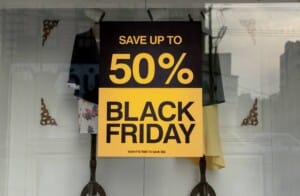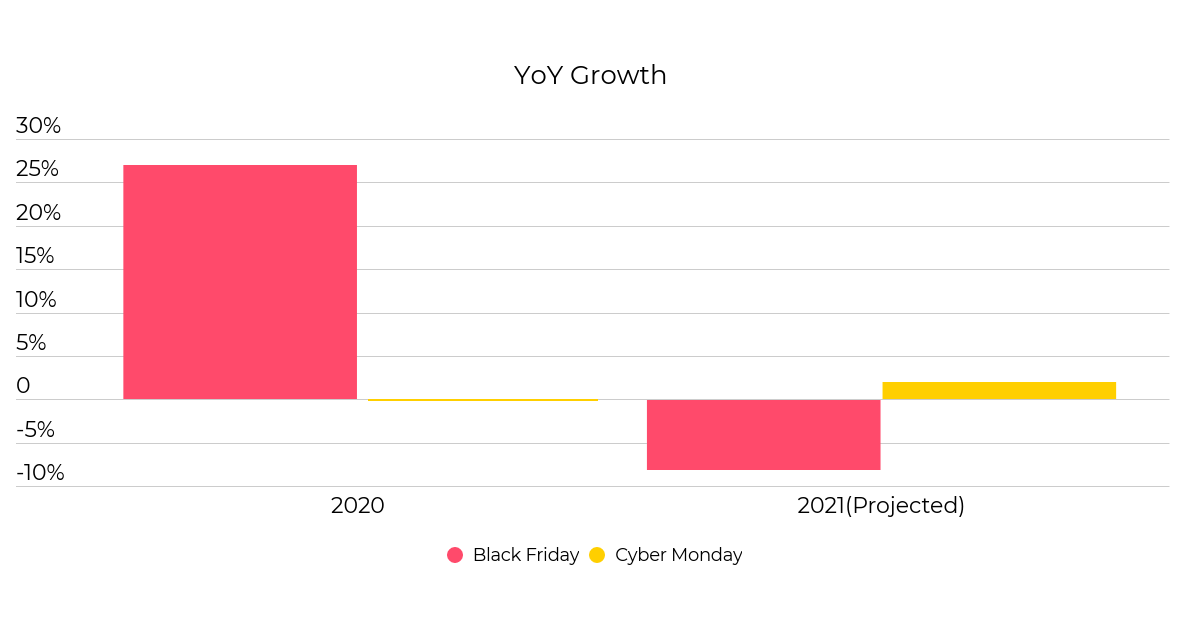Why You Shouldn’t Bank on a Big Black Friday This Year

The 2020 holiday season was an unprecedented time for marketers; after years and years of fine-tuning our budget planning and seasonality models, all of our data went right out the window as the global pandemic capsized the predictability of consumer shopping behaviors.
Naturally, retailers are eager to see how 2021’s Black Friday and Cyber Monday play out. We’ve done some research to predict what the Cyber 5 will look like this year, and to unpack what happened in 2020.
Though not totally unforeseeable, perhaps the biggest mistake among marketers in 2020 was assuming that Cyber Monday would continue to reign supreme over Black Friday as their largest eCommerce day of the year; in 2019, this was the case for 62% of WITHIN clients, but in 2020, it was true for only 33%.*
Jubilance over Black Friday success quickly turned into disappointment for unsuspecting marketers as +27% average YoY sales growth on Black Friday transitioned into 0% YoY sales growth on Cyber Monday across our client-base in 2020. Brands who saved their budgets for Cyber Monday found that much of the demand they expected to cash in on had already dried up.
What Upended This Long-Standing eCommerce Trend in 2020?
Two factors stand out to the data experts at WITHIN: the shift from in-store shopping to online and a more extended promotional season for many brands, with some turning on promotions as early as mid-October.
During the three weeks leading up to Thanksgiving, on average, brands in our database saw revenue up +27% YoY compared to just +14% during the tentpole period from Thanksgiving through Cyber Monday — shoppers were clearly buying earlier, leaving less share of wallet as the holiday season wore on.
But why would the shift from in-store to online sales also favor Black Friday over Cyber Monday? After all, the effects of the pandemic were largely constant within this timeframe.
The answer is simple: Black Friday was traditionally centered around the in-store experience while Cyber Monday was already the largest eCommerce day of the year. There was simply more unfulfilled in-store demand for the eCommerce world to scoop up on Friday than Monday.
What Will Happen This Year on Black Friday and Cyber Monday?
The outcome in 2021 will largely be dependent on the two factors discussed above: in-store shopping levels and macro-seasonality trends due to a more extended sales cycle.
To tackle the latter factor first, we can look at the seasonality for WITHIN client data to this point. Brands in our database have seen just +3% YoY growth in each of the first two weeks of November whereas in 2020, the YoY growth jumped from +10% to +28% from week one to two. Based on this data, it’s fair to say that this trend has leveled out — the extended promotional season and its effects on seasonality are here to stay.
Levels of in-store shopping, however, look much different than they did a year ago. Approximately 40% more consumers plan to shop in-store on Black Friday this year compared to last year. Based on our insight from 2020, this implies that Black Friday demand will be pulled from eCommerce shopping carts back to the stores’ in 2021. By how much though?
Last year, there was a 27 percentage point YoY swing in favor of Black Friday growth; +27% YoY growth on Black Friday vs just +0% on Cyber Monday. According to WITHIN’s data experts, brands should expect an approximately 10 percentage point swing in the opposite direction this year; -8% YoY growth on Black Friday vs +2% on Cyber Monday. (See graph of WITHIN data and projections below.)
If you’re a brand like many of ours that have seen your YoY growth flatten so far this November (average +3% YoY growth vs +20% in 2020), expect that trend to only worsen come Black Friday, which was one of the most demand-inflated days of last holiday season. Making matters worse, the ad auction may be none the wiser, making your ad dollars on Black Friday this year even less effective, as unsuspecting advertisers bank on last year’s trend persisting.
What’s the best course of action, based on this data?
- Reevaluate the projections and goals for your business based on how realistic they are. Ambitious goals are great, but market factors tend to trump ambition.
- Move your budget to periods with a better combination of demand and auction dynamics. The effective premium on Black Friday inventory will be bigger than ever this year, given the lower anticipated demand, so heed warning and shift dollars either forward or backward into early December.
Don’t wait until Black Friday to pivot your decision-making; use these insights from WITHIN’s data experts to more efficiently plan your budget for the holiday season and stay tuned for more updates along the way!
*Based on a sample of more than 40 eCommerce brands and $5B+ in revenue.
Featured image by Ashkan Forouzani on Unsplash.
